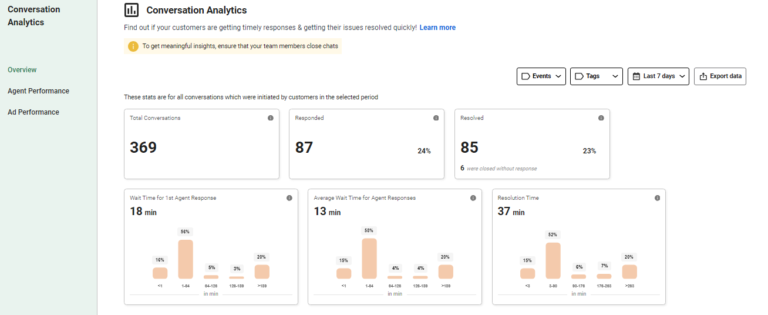With Conversation Analytics you can measure your team’s responsiveness to your customers’ messages on Interakt. As a business, after you have taken the wise decision of including WhatsApp as a crucial channel for customer communication, you need to start measuring and improving that communication as well. Customers expect super quick responses and resolution via WhatsApp and if your business provides that, they will find comfort in transacting with you.
To figure out whether your team is super quick in responding to and resolving customer conversations, we provide some metrics:
1. Total Conversations
Responded
2. Resolved
3. Wait Time for 1st agent response
4. Average Wait Time for Agent Responses
5. Resolution Time

You can filter the above metrics for specific periods like
• Last 7/30/90 days
• Yesterday
Or, you can also set custom dates.
Definitions of Metrics:
Total Conversations: Number of conversations initiated by customers in the selected period.
What is a conversation?
A chat on Interakt is made up of different conversations.
Every time you close a chat (by clicking the tick mark at the top right of the chat panel), a conversation ends. The 1st message sent by you or your customer in a closed chat starts a new conversation again.
Note: We don’t consider notifications sent via campaigns or any automated messages (like out-of-office messages) as part of a conversation.
It is very important that your team actively closes chats when the chat does not require their attention anymore. Unless this is done, the analytics won’t be meaningful for you.
Why do we say so?
Suppose, a customer reached out with an issue on 13 July at 2 PM that was solved on 13 July itself within 15 minutes (2 pm to 2:15 pm). Similarly, the resolution time for the same customer on two other dates – 15 July and 17 July was 10 minutes each. However, if the chat hadn’t been closed on those 3 days, the entire exchange would have still been 1 unresolved conversation, which in turn, wouldn’t be an accurate representation of reality.
Responded: Out of customer-initiated conversations, those conversations that were responded to, by your team, in the selected period.
Resolved: Number of customer-initiated conversations that were responded to and closed in the selected period.
Closed without Response: Number of customer-initiated conversations that were closed without a response in the selected period. Check out Example 2 below to see an instance of how this metric is calculated.
Wait time for first agent response: Time is taken to respond to the customer’s first message in a customer-initiated conversation. On the dashboard, we show a median of 1st response times across different conversations.
Average Wait time for agent responses: Average time taken to respond to all customer messages in a customer-initiated conversation. Then, a median of the averages obtained from different conversations is taken.
Note: Only closed conversations are considered for this metric.
Resolution time: Time taken to resolve customer-initiated conversations (duration between the 1st and last messages in the conversation). On the dashboard, we show a median of resolution times across different conversations.
Still confused? We have explained this below using 2 simple examples:
Example 1:
Total Conversations: 3
Responded: 3
Resolved: 3
Closed without Response: 0
1st Response Time:
=> Median of (2:10 – 2), (4:10 – 4), (3:20 – 3)
=> Median of (10, 10, 20)
=> 10 mins
Average Response Time:
=> Median of:
Average (2:10 – 2), (4:15 – 3)
Average (4:10 – 4)
Average (3:20 – 3)
=> Median of (42.5, 10, 20)
=> 20 mins
Resolution Time:
=> Median of (4:15 – 2), (4:10 – 4), (3:20 – 3)
=> Median of (135, 10, 20)
=> 20 mins
Example 2
Total Conversations: 2
Responded: 1
Resolved: 1
Closed without Response: 1
1st Response Time:
=> Median of (2:15 – 2)
=> 15 mins
Average Response Time:
=> Median of:
Average (2:15 – 2), (4:10 – 4)
=> Median of 12.5 mins
=> 12.5 mins
Resolution Time:
=> Median of (4:10 – 2)
=> 140 mins
If you want to see data for each conversation, you can click on ‘Export Data’ to obtain a CSV of all conversations in the selected time period. Here, you can conduct your own analysis to get a deeper understanding of how your customers are being responded to.
We strongly suggest setting targets for each of these metrics and aligning your team on those targets. We will soon be sending you weekly emails with a summary of the week’s performance. Having a weekly review with the team should be helpful in gradually achieving your set targets and enhancing your customer’s experience on your WhatsApp channel!
We hope this article helped you understand how the Conversation Analytics work on Interakt’ WhatsApp Business Platform.




